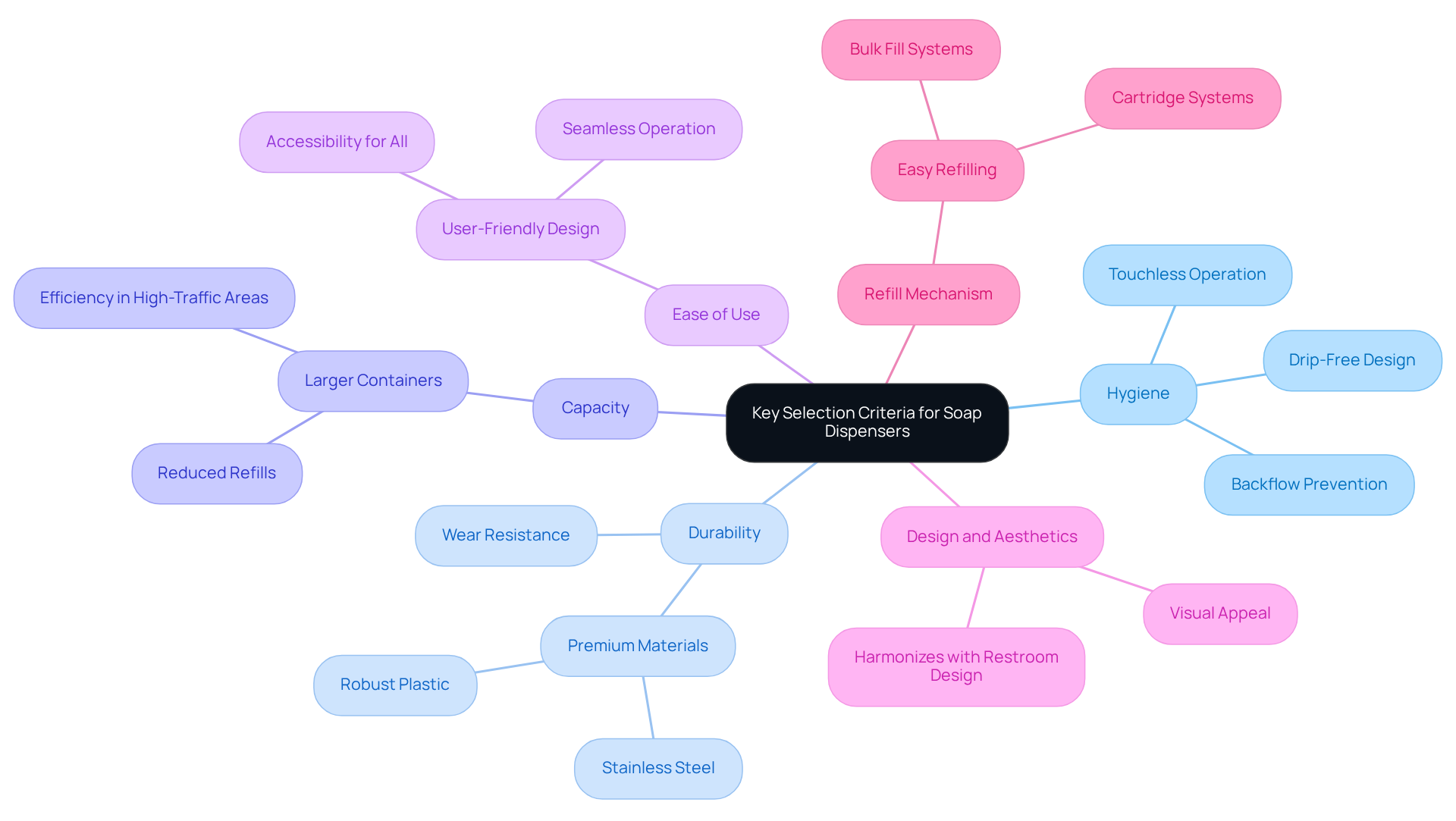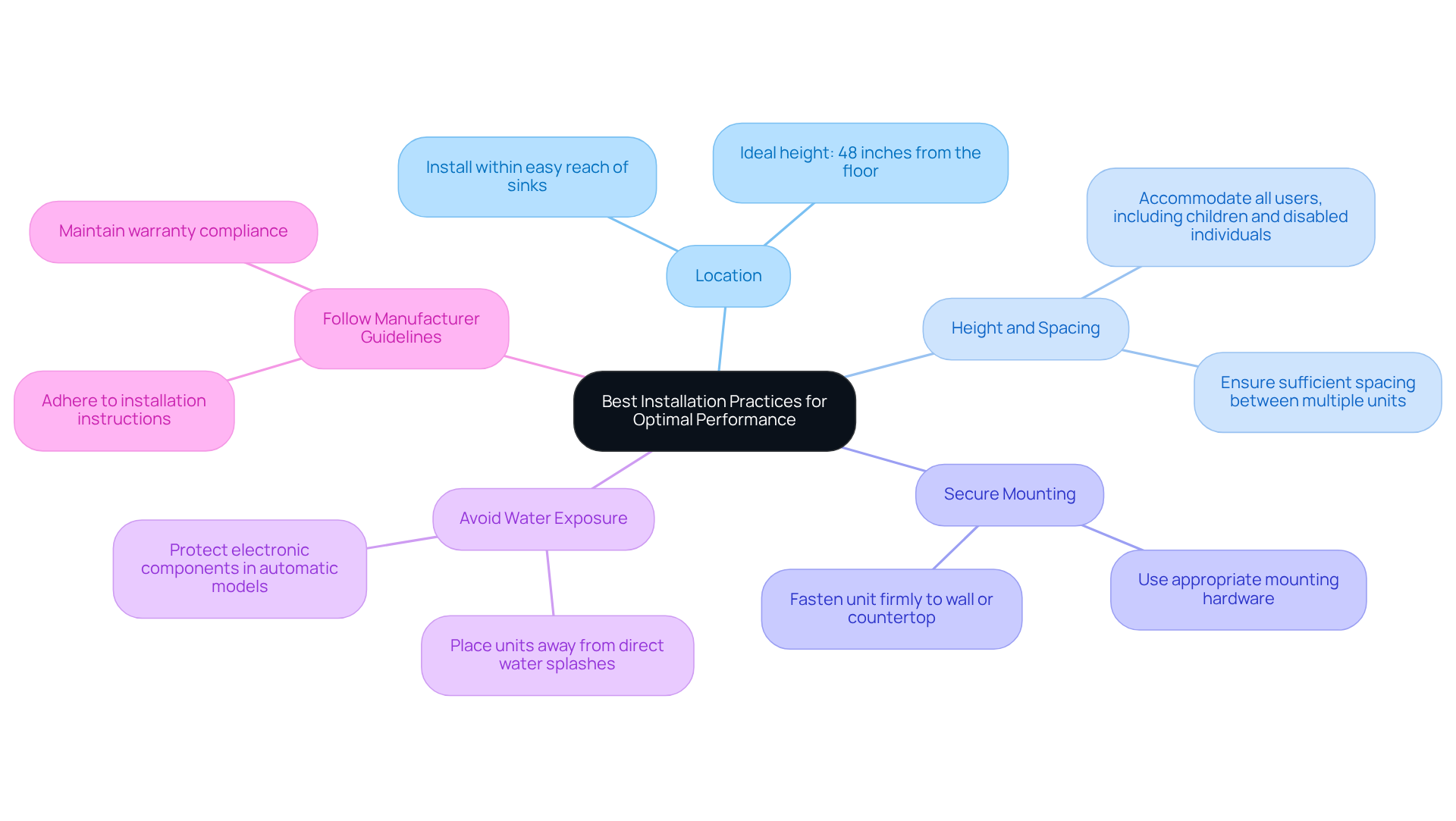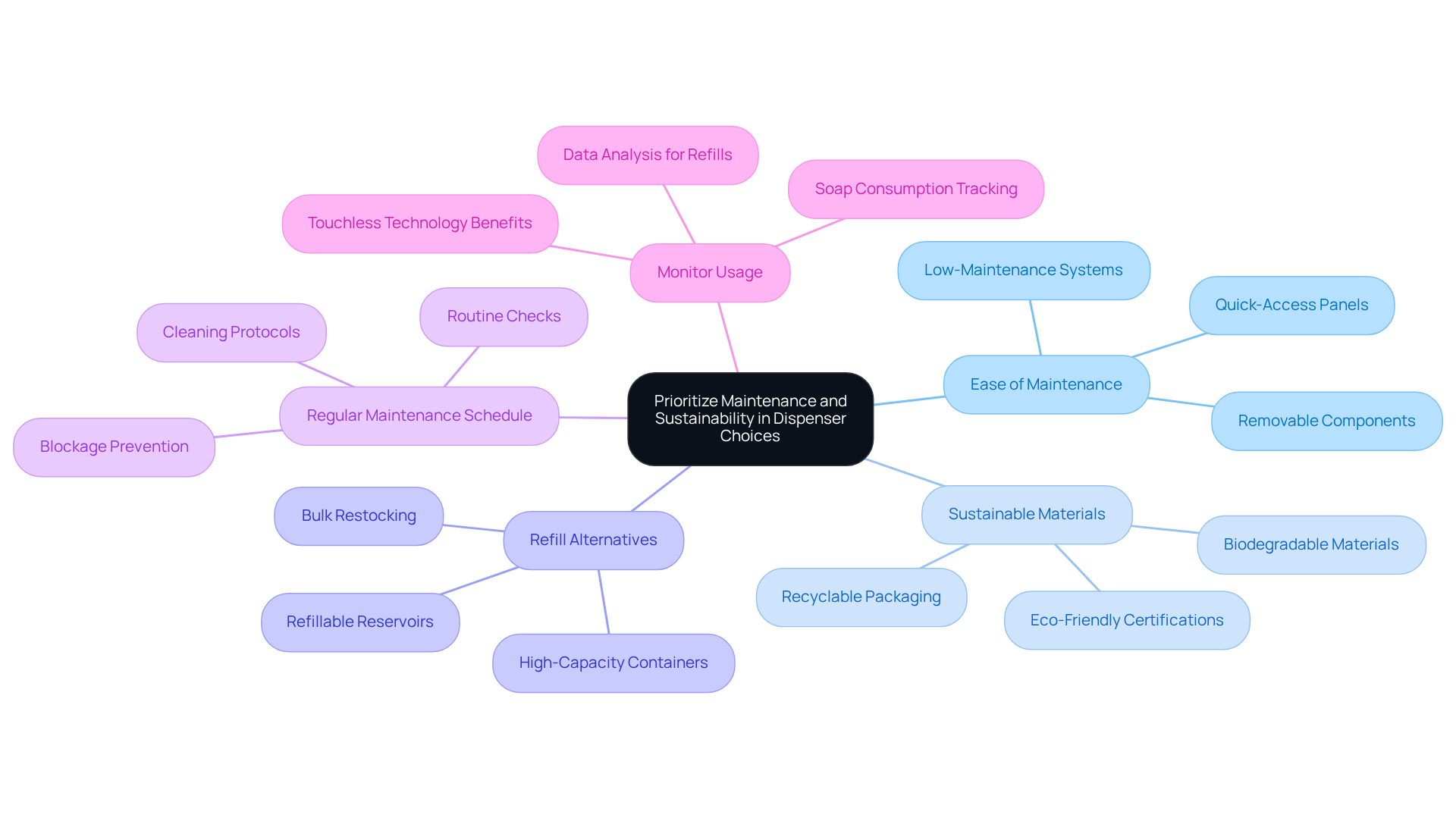Overview
Selecting the right soap dispensers for commercial use hinges on three key practices:
- Prioritizing hygiene through touchless designs
- Ensuring durability with high-quality materials
- Assessing capacity for efficiency in high-traffic areas
These criteria not only enhance sanitation and longevity but also contribute significantly to a more efficient and user-friendly restroom experience. Ultimately, this approach supports both operational effectiveness and customer satisfaction, establishing a standard for excellence in restroom facilities.
Introduction
Selecting the right soap dispenser for commercial use is a critical decision that profoundly impacts hygiene, efficiency, and user experience. In an era where cleanliness in public spaces is paramount, understanding the essential criteria for choosing these dispensers is vital to significantly enhance sanitation efforts. However, with a myriad of options available, how can businesses ensure they are making the best choice that effectively balances functionality, sustainability, and cost-effectiveness? This article delves into three key practices that guide organizations in selecting the ideal soap dispensers, ensuring they meet both operational needs and hygiene standards.
Define Key Selection Criteria for Soap Dispensers
When selecting soap dispensers for commercial use, it is essential to consider several key criteria that ensure both functionality and hygiene.
-
Hygiene: Opt for touchless or automatic devices to minimize contact and significantly reduce the spread of germs. It is crucial to choose models that prevent backflow contamination and dripping, thereby enhancing overall sanitation.
-
Durability: Select units made from premium materials such as stainless steel or robust plastic. These materials are designed to withstand regular use in busy environments, ensuring longevity and reliability.
-
Capacity: Assess the volume of soap the container can hold. Larger containers are particularly advantageous in high-traffic areas, as they decrease the frequency of necessary refills, promoting efficiency.
-
Ease of Use: Ensure that the device is user-friendly, allowing for seamless operation by all individuals, including children and those with disabilities. This accessibility is vital for maintaining a welcoming environment.
-
Design and Aesthetics: Choose units that harmonize with the restroom's overall design, enhancing the space's visual appeal while maintaining essential functionality. A well-designed soap dispenser for commercial use can significantly elevate the restroom's ambiance.
-
Refill Mechanism: Consider units that facilitate easy refilling, whether through bulk fill or cartridge systems. This feature streamlines maintenance processes, ensuring that the dispensers remain operational with minimal downtime.

Implement Best Installation Practices for Optimal Performance
To ensure optimal performance of soap dispensers, it is essential to adhere to best installation practices that promote effective use and enhance hygiene.
-
Location: Install units within easy reach of sinks, ideally 48 inches from the floor. This height encourages regular use and significantly promotes hand hygiene among users.
-
Height and Spacing: Maintain a height that accommodates all users, including children and individuals with disabilities. Furthermore, ensure sufficient spacing between multiple units to prevent crowding and facilitate easy access for everyone.
-
For secure mounting of soap dispensers commercial, use appropriate mounting hardware to fasten the unit firmly to the wall or countertop. This step is crucial in preventing accidental dislodging or tampering, thereby ensuring the unit remains functional and accessible.
-
Avoid Water Exposure: It is advisable to place units away from direct water splashes. This precaution helps prevent damage to electronic components, particularly in automatic models, thus extending their lifespan.
-
Follow Manufacturer Guidelines: Lastly, adhere strictly to the installation instructions provided by the manufacturer. Doing so not only ensures proper functionality but also maintains warranty compliance, safeguarding your investment.

Prioritize Maintenance and Sustainability in Dispenser Choices
When selecting soap dispensers commercial for use, prioritizing maintenance and sustainability is essential. This can be achieved through several key practices:
-
Ease of Maintenance: It is crucial to select devices designed for simple cleaning and refilling. Models featuring removable components facilitate the cleaning process, minimizing downtime and ensuring consistent hygiene. For instance, devices equipped with quick-access panels for battery replacement significantly lessen staff workload.
-
Sustainable Materials: Opting for containers made from recyclable or biodegradable materials is vital to reducing environmental impact. Seek certifications that confirm eco-friendliness, as these can guide responsible purchasing decisions. The LESSEAU system exemplifies this approach, utilizing fully recyclable packaging that aligns with users' 'zero plastics' targets.
-
Refill Alternatives: Choosing units that accommodate bulk restocking greatly minimizes plastic waste and decreases operational expenses. This strategy not only aligns with sustainability initiatives but also enhances the overall efficiency of restroom management by utilizing soap dispensers commercial. High-capacity liquid containers, such as the IFS04W model, allow for 2250 hand washes per fill, reducing the frequency of purchases and waste.
-
Regular Maintenance Schedule: Establishing a routine maintenance plan to check for blockages, replenish liquid, and clean containers is imperative. This proactive strategy ensures that units remain functional and hygienic, contributing to a positive restroom experience. Industry experts note that regular checks can prevent service interruptions and maintain hygiene standards.
-
Monitor Usage: Utilizing systems to track soap consumption enables timely refills and minimizes waste. Analyzing this data can inform future purchasing decisions and bolster sustainability efforts, ensuring that restroom facilities operate efficiently and responsibly. Touchless dispensers, for instance, not only reduce the spread of germs but also enhance user experience by minimizing physical contact. Gaetano Redaelli emphasizes the importance of hygiene in high-traffic areas, underscoring the value of these systems.

Conclusion
Selecting the right soap dispensers for commercial use is a critical decision that significantly impacts hygiene, functionality, and the overall user experience. By focusing on essential criteria such as:
- Hygiene
- Durability
- Capacity
- Ease of use
- Design
- Refill mechanisms
businesses can ensure they choose dispensers that meet operational needs while promoting a clean and welcoming environment.
This article highlights several key practices, including optimal installation techniques, maintenance considerations, and sustainability options. Proper placement and secure mounting enhance usability, while routine maintenance and the choice of eco-friendly materials contribute to long-term efficiency and environmental responsibility. Furthermore, by integrating these insights, businesses can create a restroom experience that prioritizes cleanliness and accessibility.
Ultimately, the selection and management of soap dispensers should reflect a commitment to hygiene and sustainability. As businesses strive to meet the evolving expectations of their customers, implementing these best practices will not only improve operational efficiency but also foster a healthier environment. Embracing these principles is essential for any organization looking to enhance its public spaces and promote responsible practices in today's commercial landscape.
Frequently Asked Questions
What are the key criteria for selecting soap dispensers for commercial use?
The key criteria include hygiene, durability, capacity, ease of use, design and aesthetics, and refill mechanism.
Why is hygiene important when selecting soap dispensers?
Hygiene is crucial because touchless or automatic devices minimize contact and reduce the spread of germs. It's also important to choose models that prevent backflow contamination and dripping to enhance sanitation.
What materials are recommended for durable soap dispensers?
It is recommended to select units made from premium materials such as stainless steel or robust plastic, which can withstand regular use in busy environments.
How does the capacity of a soap dispenser affect its functionality?
The capacity affects functionality by determining how much soap the container can hold. Larger containers are beneficial in high-traffic areas as they reduce the frequency of necessary refills, promoting efficiency.
What should be considered regarding the ease of use of soap dispensers?
The device should be user-friendly, allowing for seamless operation by all individuals, including children and those with disabilities, to maintain a welcoming environment.
How does the design and aesthetics of a soap dispenser impact a restroom?
The design and aesthetics should harmonize with the restroom's overall design, enhancing the visual appeal while maintaining functionality, which can elevate the restroom's ambiance.
What features should be looked for in the refill mechanism of soap dispensers?
Units that facilitate easy refilling, whether through bulk fill or cartridge systems, should be considered to streamline maintenance processes and ensure that the dispensers remain operational with minimal downtime.




